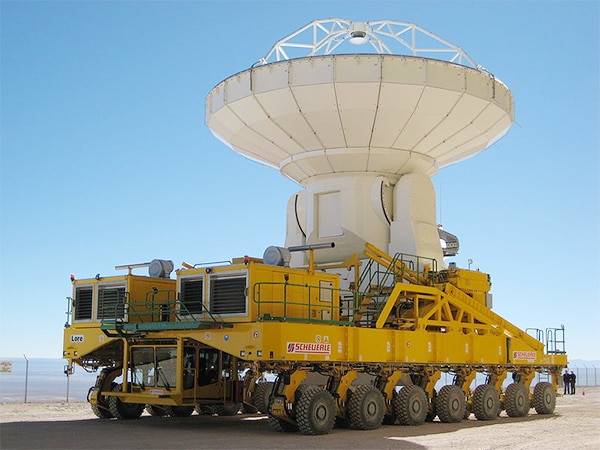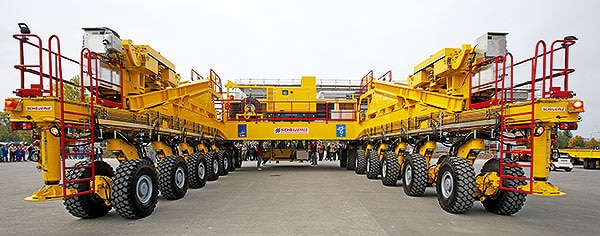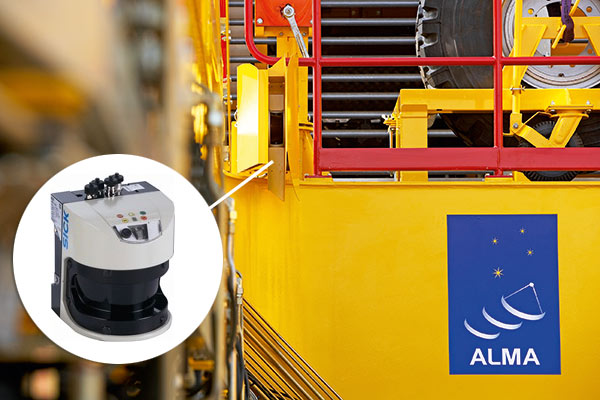ALMA stands for Atacama Large Millimeter/Submillimeter Array, a terrestrial space observatory in the Chilean Atacama desert, more than 5000 meter above sea level. It consists of about 66 individual radio telescopes which can be moved and connected in series whereupon the worlds largest array of antennas occurs which is able to expand into the most remote, coldest and, to the human eye, darkest regions of the universe. LMS outdoor 2D laser scanners from SICK assist with the positioning of the vehicles in picking up and setting down the radio telescopes and preventing collisions within and around the vehicles. (Picture © ESO/Pascal Martinez)
 © ESO/Pascal Martinez
© ESO/Pascal Martinez
The giant transporters from the special vehicle manufacturer Scheuerle are two vehicles of the same make with a total weight of 250 tons, measuring 20 m in length, 10 m in width, and 6 m in height. They were ordered by the European Southern Observatory, ESO, the European organization conducting astronomical research in the southern hemisphere. The radio telescopes are earmarked for the ALMA project - a cooperative effort of ESO with North America, East Asia, and Chile in the latter countrys Atacama Desert, which due to its aridity and geographical position is a tried and tested location for research into the universe from the earth.

ALMA - new research opportunities due to mobile array of antennas
The radio telescopes - each one with a diameter of 8 m to 12 m - are used to advance into the most remote and coldest regions of the universe, the darkest to the human eye - with a resolution ten times better than the Hubble space telescope. The special feature of ALMA is that the individual radio telescopes are mobile, forming the worlds largest array of antennas. Depending on the research assignment, the individual telescopes weighing about 130 tons can be positioned, aligned, and then connected in series on approx. 200 concrete foundations spread over an area of about 225 km² - to constitute one giant merged radio telescope with inconceivable ranges. The mega trucks made by Scheuerle provide for the required mobility of the radio telescopes.
 ALMA mobile antenna array © ESO/C. Malin
ALMA mobile antenna array © ESO/C. Malin
The Atacama Desert makes harsh demands on mega trucks and sensor technology
Temperatures as low as -50° C in winter and up to +50°C in the summer, low-oxygen air that reduces the 1,360 hp rated power of the two diesel engines to a mere 820 hp, dusty roads and paths, radiation from space, as well as the special cargo: these factors make numerous special demands on the material and technology featured in the two radio telescope transport vehicles. Many components that can be used in serial production were not usable for the radio telescope transporter project, or had to be modified due to the special operating conditions, confirms Andreas Kohler, assistant manager at Scheuerle. The first assignment of the vehicles involves transporting the radio telescopes from the base camp at an altitude of 2,900 meters, where the telescopes will be assembled, to the observatory located on the high plateau at 5,000 meters - passing along a gravel road some 28 km long with gradients of up to ten percent. They are used to move the radio telescopes around inside the array of antennas.
Outdoor-proof LMS brave adverse operating conditions
In both types of tasks, four laser scanners overall, mounted on the vehicles, protect them and the radio telescopes from collisions, also assisting with the fine positioning of the vehicles while picking up and setting down the sensitive installations with the inclined elevator. For lifting up, the transport vehicle backs up to the radio telescope.
 Mega truck with SICK's outdoor 2D laser scanner
Mega truck with SICK's outdoor 2D laser scanner
Although the hydrostatic travel drive allows ultra-precise positioning, LMS monitor the sides of the pick-up device as well as the area between the two lateral inclined elevators. If a laser scanner detects that the positioning in front of the radio telescope intended for pick-up needs to be corrected, the LMS recognizes this, and the driver receives a corresponding indication in the cab. If such a signal does not occur, the driver can rely on correct positioning and lift the radio telescope from the mounting within the foundation. In an analogous way, the LMS also assist the driver before setting down a telescope during positioning in front of the foundation. Using the laser measurement systems that monitor the exterior of the vehicle ensures that no collisions with other objects in the operating area occur while driving and maneuvering the vehicles. Therefore the scientists manage, by flexibly connecting the mobile ALMA radio telescopes, to peer into space with unequalled depth, thus attaining new insights, then the laser scanners from SICK contribute a small, though not insignificant part to this achievement.
Video: "Gentle Giants in the Desert"
Source: Eso Observatory, YouTube
- Product information: LMS511 outdoor 2D laser scanner
- Prodct portfolio: outdoor 2D laser scanners
- Website: ALMA (Atacama Large Millimeter Array)
- Customer information: Scheuerle

